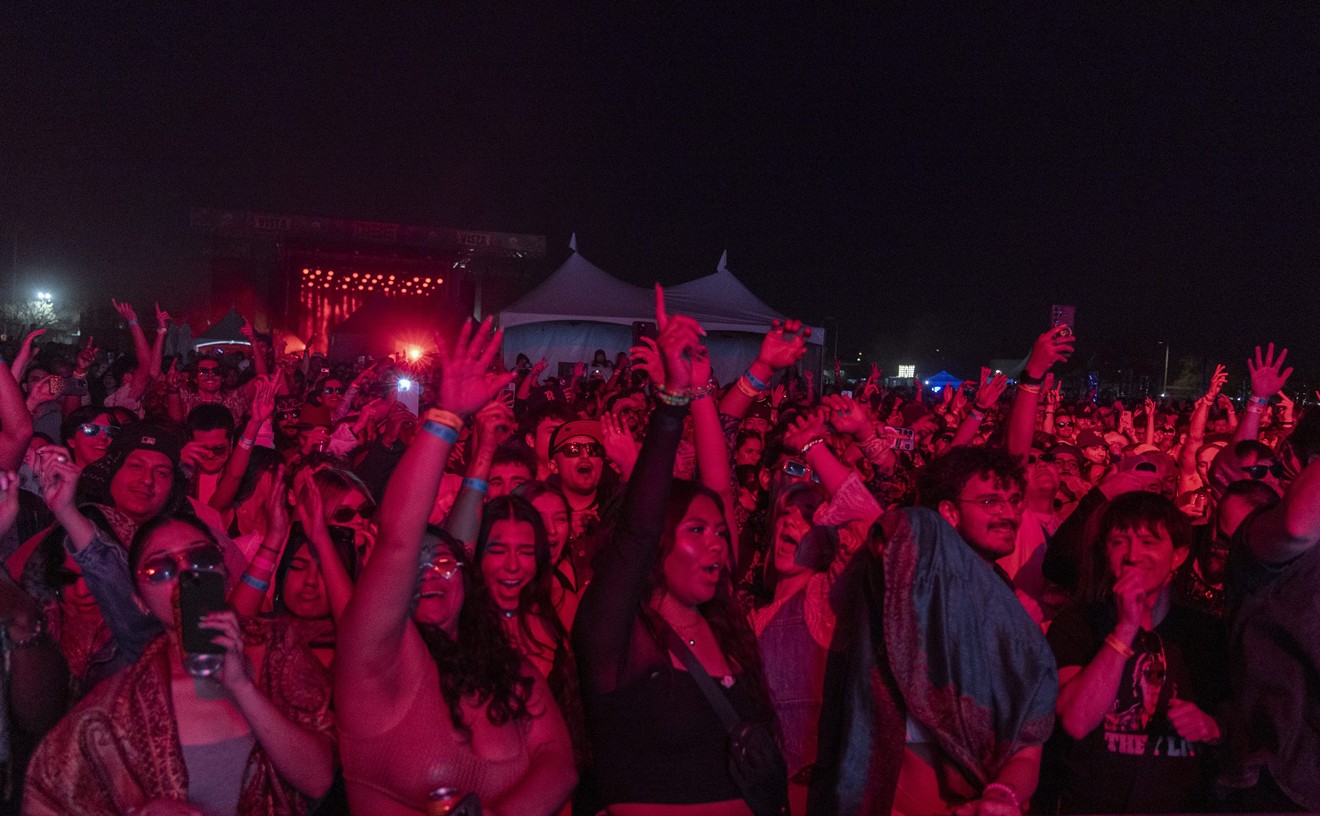Curious what's going on around town this weekend? Need some suggestions as to how to rock, dance, or krump in the Valley of the Sun?
Don't fret: These are our Five Shows to See This Weekend.
Friday, November 23: Lauren Farrah's Great Expectations Listening Party @ Arizona Hi-Fi
Center stage, her honey-brown hair falling in her face, Lauren Farrah crouches over her acoustic guitar. Her voice rises and falls in short bursts, echoing in the Icehouse in downtown Phoenix.The Roaring Twenties-era venue screams cool, post-apocalyptic chic with its stark, open-air rooms with towering concrete walls. She's performing on a dreary Wednesday as part of a special "Garden Party" hosted by local psych-folk band Wooden Indian.
A Buddha statue stands behind Farrah, and a few girls surround her, swinging hula-hoops as one woman wraps mailing tape around another woman's arm. In a room behind Farrah, B horror movie paintings -- Dracula, abducted cows, et al. -- line the walls. Hipsters sip BYOB leftovers in the cold, as the last drops from a brief storm rain down. As Farrah sings, "Oh, lord, I want to break away clean," in whispered pleas, she appears slightly out of place in this jumbled and repurposed art scene.
Or, maybe she isn't. Farrah rolls a cigarette and sips a pumpkin-flavored New Belgium brew as she tells me how she went from being a CTI (cryptologic technician interpretive) in the Navy to getting signed to River Jones Music less than three months ago.
With her hushed voice and country-tinged folk, Farrah fits nicely on Jones' young roster, alongside Sareena Dominguez, Michelle Blades, and Courtney Marie Andrews. But Farrah's voice sounds more aged, huskier, and more weathered than most of Jones' signees.
"When I was younger, what I listened to was censored a lot by my mom because she was a charismatic Christian," Farrah says reflectively. "[I listened to] mostly big band and swing, old jazz, and stuff like that. Early years, that's probably where I got maybe a little bit of the vocal style from. Billie Holiday, Ella Fitzgerald, those sorts of ladies. Smoky and smooth and I hope I'm doing it justice." -- Troy Farah
(Read the entire Lauren Farrah feature.)
Friday, November 23: The Faint @ Crescent Ballroom
When The Faint's seminal album, Danse Macabre, was released 11 years ago, its combination of pulsing synths and heavy guitars made the band stand out. Sure, bits and pieces sounded like New Order or Depeche Mode, but there was a modern urgency that still rings loud and clear over a decade later.
"We wanted to be polarizing . . . We wanted people to either love it or hate it," says singer Todd Finke. "I think that attitude gave us the freedom to just go all the way when we felt like it without being scared, because you accept that people are going to hate it."
Even as other indie rock bands have swapped their guitars for synthesizers, Danse Macabre remains an enduring classic. "I'm still happy with it, and that's pretty much all I can really hope for."
Tired of the endless cycle of releasing albums and touring, The Faint went on hiatus for a couple of years. In August, Saddle Creek Records announced a deluxe reissue of Danse Macabre to coincide with the band's playing the album in its entirety at shows on a 24-date tour. The set comprises the 35-minute album, as well as hits from Wet From Birth and Blank-Wave Arcade and a handful of new songs. -- Melissa Fossum
(Read the complete Faint interview.)
Saturday, November 24: The Maine @ Marquee Theatre
Though the pop music landscape has changed dramatically in the past decade, The Maine cites as heroes artists who have benefited from Warner Brothers' traditional, career-minded approach, artists like Jack White, Tom Petty, and Neil Young.
But when the band's label rejected their record, Pioneer, the chief inspiration for fighting for it was an even closer Warner Brothers associate: former CEO Tom Whalley.
"I think what actually sparked our entire process was a dinner in New Jersey, with [Whalley] when he was CEO," says singer John O'Callaghan. "He had us over at his beach house on the Jersey Shore, which is like 50 feet from the beach, in the summer of 2010. And kind of the whole gist of the talk we had was basically him saying, 'Never compromise. Do you think Jack White or Neil Young ever compromised?'
"And he said, 'If you have faith in what you're doing, and you really believe in it, never let anybody outside of that alter that.' It was really weird, because the whole talk sounded like he was going to quit or resign or whatever. Well, two weeks later, we get this e-mail that says Tom Whalley has stepped down [as CEO]. It was this weird, kind of last message to us. The guy who [was] in the studio with Green Day -- listening to the record, making sure it's good -- is telling us, don't give in to what these people around you are telling you. He was telling us to give hell to all the people he was working with." --Jason P. Woodbury
(Read more about The Maine's Pioneer.)
Saturday, November 24: Whiteout 5 @ Stratus ft. 12th Planet
John Dadzie is swiveling back and forth in an office chair at his tidy downtown loft, surrounded by computers, synthesizers and an antiquated mixing board. This is where Dadzie transforms into 12th Planet, the DJ and producer responsible for bringing the emerging electronic strain of dubstep to America. In fact, with the help of his roommates -- his manager and his tour manager -- this spot has effectively become the center of the stateside dubstep universe. The genre's biggest star, Skrillex, uses Dadzie's sofa as a crash pad after studio sessions.
Usually found in jeans, a T-shirt and a baseball cap, Dadzie is black and sports a Van Dyke. Unlike other DJs, who foster larger-than-life images, he's got a boy-next-door appeal and a charming smile, both of which belie the bass-heavy, half-time apocalyptic sounds he's known for. When he caught wind of dubstep, it was emerging from London's underground dance clubs in the mid-aughts. With his help, it migrated to L.A. and now dominates the U.S. festival circuit, and even the frat house.
Though he shrugs off his influence, Dadzie has been showered with attention from everyone from Urb to Spin, while local promoter Drew Best calls him the "Johnny Appleseed of dubstep." Dadzie's an influential producer: His recent The End Is Near! EP features the genre's hottest studio wizards -- but he has the soul of a DJ, and an uncanny ability for trend spotting. He helped popularize Canadian producer Datsik, and he championed Skrillex before most had heard of him, long before he was on the cover of L.A. Weekly and Billboard. Dadzie asked Skrillex to collaborate; Skrillex returned the favor by bringing him along on his first headlining tour this past fall. -- Liz Ohanesian
Sunday, November 25: Rush @ US Airways Center
When Canadian rock trio Rush debut in 1974, liking the band as a teenager was a risky proposition.
On one level, there's nothing about the band's essential makeup that should render them "off limits" to the cool kids. Rush was a progressive, hard rocking band influenced as much by Cream and Led Zeppelin as Deep Purple, and as thus accepted by my Blue Oyster Cult- and Black Sabbath-loving friends.
But on another level, Rush was something else. A thinking-man's band, with cerebral lyrics steeped in fantasy, Ayn Rand Objectivism, and science fiction. The band was all about complex, shifting rhythmic changes, multi-movement song structures (considered by your average teen as classical music-oriented, and thus less cool), and a nasally singer ala Yes. In other words: nerd territory for the The Hobbit-reading and Dungeons and Dragons-playing set ostracized to a far corner of the school yard.
It was a fine line to walk for the awkward teen, and 2112, with its epic 20-minute title track, or Hemispheres, complete with the gripping "La Villa Strangiato" instrumental, were more likely heard (on 11, naturally) on the home hi-fi, the one in your room, than on nights out cruising with friends.
But the breakthrough -- and Rush's biggest commercial success -- came with Moving Pictures, in 1981. The album offered the quintessential car-fantasy of "Red Barchetta" and free spirited rebel in "Tom Sawyer." Suddenly, Rush wasn't simply for the geeks. Rush was for everyone.
Like proper Howard Roarks, guitarist Alex Lifeson, bassist/vocalist/keyboardist Geddy Lee, and drummer/primary lyricist Neil Peart, weren't content to let the spotlight shift their focus away from doing whatever they felt like, a singular dedication to their own artistic direction. 30-plus years later (and 44 years since the band formed), the Grammy-winning, multi-platinum-selling band has spent time erroneously dabbling in reggae, gone synthesizer heavy for a spell, and frequently indulged in lengthy, album-filling instrumentals. Through it all, they've blazed their own path. Rock radio quit playing the new singles, but it didn't matter. Rush's fans, like the band itself, remain fiercely dedicated to high-energy, challenging music for blue- collar rockers and analytical music lovers alike.
Clockwork Angels, Rush's first album of new material in five years, follows in the band's now signature mood swing style, opening with the driving, near-metal force of "Caravan" and "BU2B," staples on the recent "Time Machine" tour. Both songs sport stinging guitars, pounding drums, and forceful rhythms among alternating time signatures. The tracks, and the similarly-styled "Carnies" (about the dark-side of carnivals), are throw backs to the band's earliest output from the self-titled debut (before Peart joined, making the "Holy Triumvirate" complete) . But there's trickier fare, too: "The Anarchist" pushes the prog-intensity with searing guitar licks, thunderous bass, eerie strings and haunting vocal interludes, while "Halo Effect" takes the edge off with acoustic guitar rhythms and leads, perfectly complimenting Lee's high vocal reach. "The Garden," bolstered by acoustic tones , is backed by strings pushing the intensity, but the strings never overpower the vocals or Lee's insistent bass. The title track opens with a call to prayer-like wail and warbling guitar before rumbling with earthquake force.
Given the storyline for Clockwork Angels, there is certainly a weighted feel from end to end. And while the band is known for its conceptual single-song storytelling, Clockwork Angels captures Peart's lyrical vision over a 12-song cycle that explores the protagonist's dreams though a vivid landscape steeped in steampunk and alchemy. The main character also encounters a mysterious carnival, hidden cities, pirates, anarchists, and "a rigid watchmaker who imposes precision on every aspect of daily life," claims a press release.
Complex and detailed enough in musical form, Clockwork Angels was also novelized (and released in September) by science fiction writer Kevin J. Anderson.
But for Rush fans it's the music that matters. With Clockwork Angels, Rush proves more than up to the task of challenging listeners on all levels, and that at this stage, one no longer has to choose between rocking or thinking about the music. Instead it's easy, and acceptable -- no matter the age or awkwardness -- to do both. -- Glenn BurnSilver









